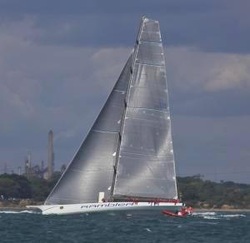
Reading about accidents may give the impression that boating is a particularly dangerous sport, but remember that safe days on the water usually are not reported in the press.
Rambler 100 racing yacht capsize, 2011 Fastnet Race.
Rambler 100, a 100ft super maxi ocean-racing sloop with a professional crew of 21, lost her canting keel on August 15th at 1740 local time, shortly after rounding Fastnet Rock in the Irish Sea. The vessel capsized in less than 60 seconds, leaving no time for crew members to take anything with them or activate distress signals. 18 people went into the water, including four without lifejackets (because they were below decks off watch). Winds were southerly at 20-25kn and gusty, with 6.5ft/2m choppy seas, and a water temperature of 57°F/14°C. Initially, three people were able to climb onto the overturned hull, and subsequently 13 more people managed to join them. Five crewmembers wearing lifejackets tied themselves together and floated away, drifting three hours before rescue. Two Personal Locator Beacon (PLB) distress beacons were activated on the overturned vessel. The crew was unsuccessful in hailing or signaling to three large racing yachts that passed to leeward of them as close as 300-400m. No lives were lost and only one person required hospital treatment (for hypothermia). Everyone was safe ashore in less than three hours, a testament to the professionalism of the Irish Coast Guard, the Baltimore RNLI lifeboat rescue teams, Rambler 100’s skipper, and the well-trained crew.
While this incident occurred on a super maxi ocean racer, accidents can happen on a small boat. Here’s a summary of the basic lessons from this event that are applicable to many boaters and their vessels.
- Develop and practice man overboard and abandon ship drills applicable to your boat and its typical crew complement (even if you normally operate with two aboard). Rambler’s crew was calm, professionally-trained, and they had conducted live MOB and abandon ship drills.
- Attend a Safety at Sea Seminar (classroom and practical training) or other comprehensive safety course. See http://offshore.ussailing.org/SAS/Seminars.htm.
- Wear a properly-fitted lifejacket, with crotch or thigh straps, and a harness and tether (safety line), at night and in conditions you deem to require it. Inflatable lifejackets with integral harness and tether are available. A spray hood on the lifejacket is recommended for offshore operations.
- The tether must be easy to release under a strain if someone becomes entangled. Crew members should carry a sharp, easily accessible knife.
- Each person’s lifejacket should be immediately accessible when not being worn.
- An automatic, water-activated inflatable lifejacket should also have a mouth inflation option. Know how to manually inflate your jacket. Inspect the lifejacket and inflate it manually once a year, following the manufacturer’s instructions.
- All crewmembers should have a sharp knife, a good whistle, a bright personal strobe light, a properly-registered Personal Locator Beacon (PLB) and/or a waterproof handheld VHF-DSC (Digital Selective Calling) radio, and a laser flare attached to their lifejackets, in a belt pack, or in accessible foul weather gear pockets. The whistles and strobes typically supplied with lifejackets are not effective.
- Keep a handheld VHF/DSC radio in the cockpit so people can use it during an emergency without going below decks.
- Consider having a small abandon ship grab bag readily accessible in the cockpit, in case of a rapid sinking. There may not be time to get the boat’s larger abandon ship bag.
 RSS Feed
RSS Feed